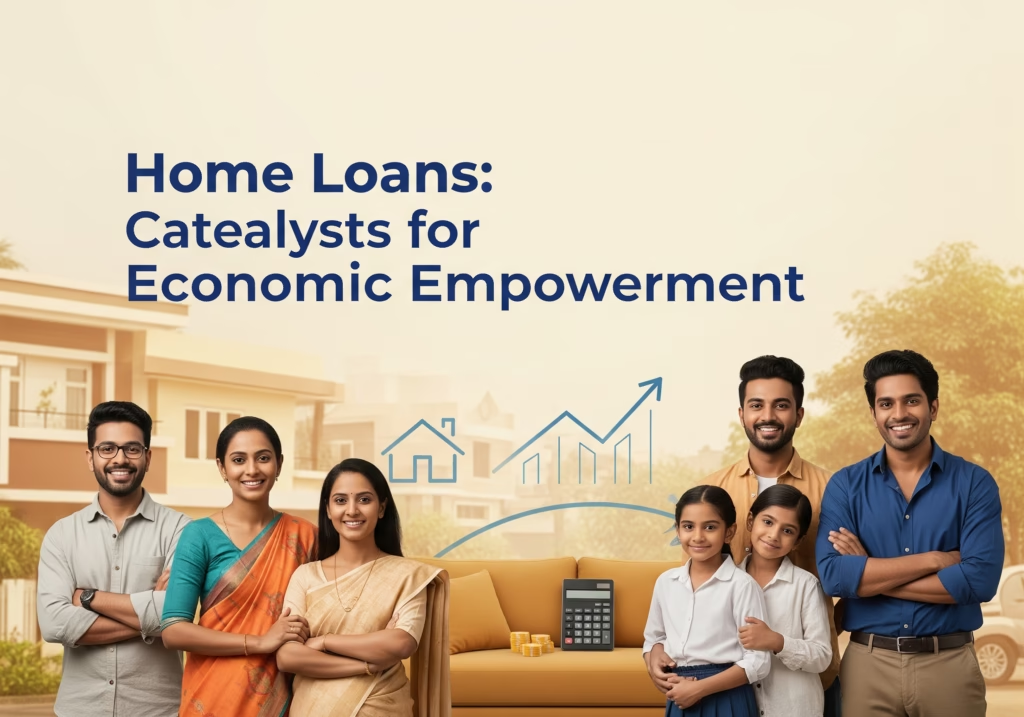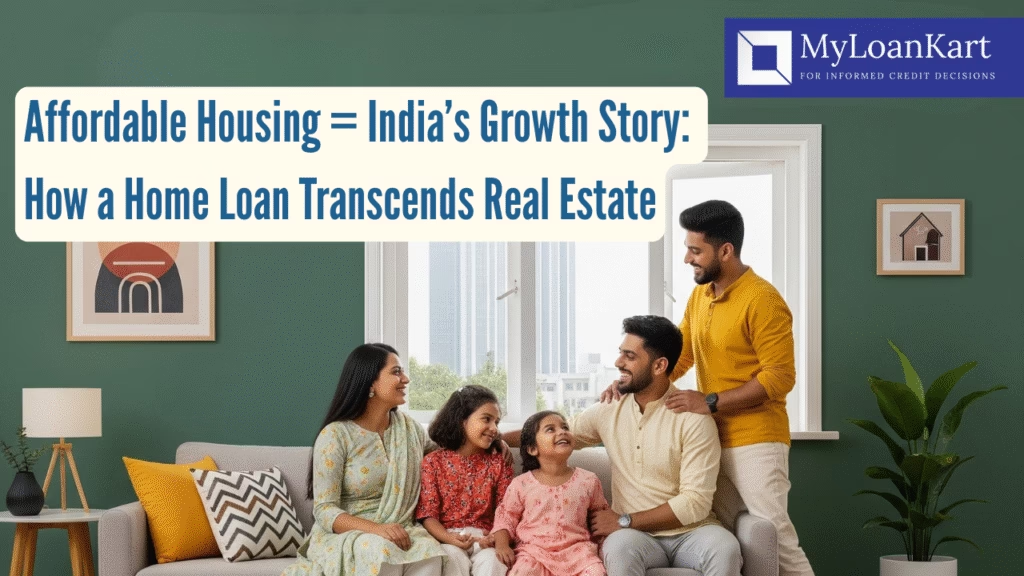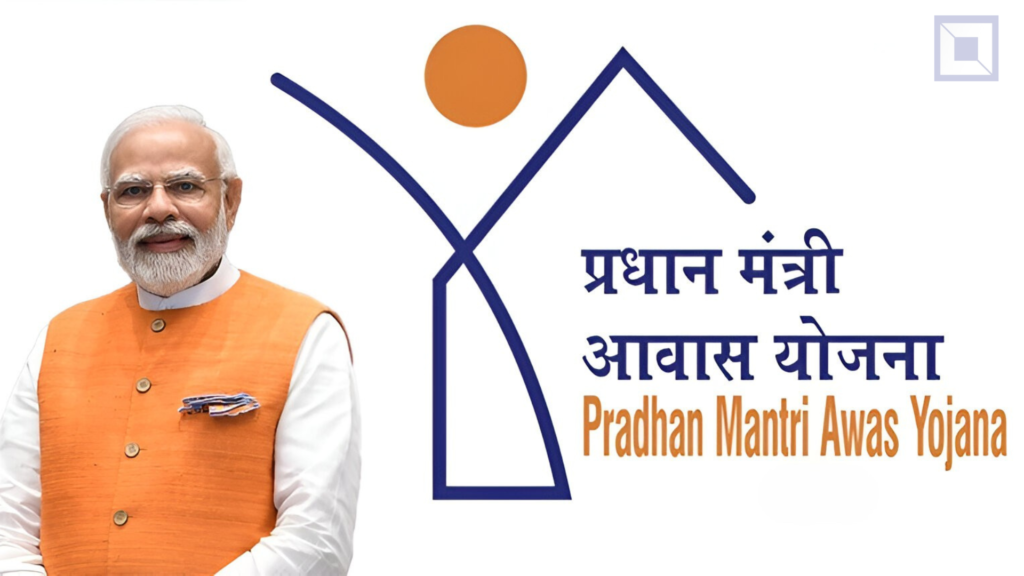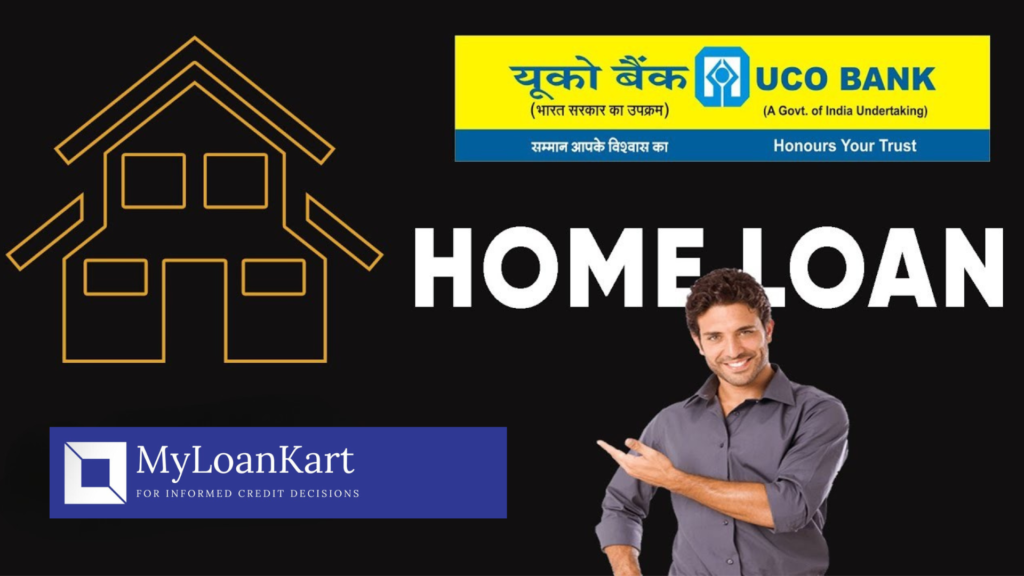Introduction
Everyone agrees that owning a home is one of the most powerful milestones in a person’s life especially in India, where it symbolizes security, pride, and progress. But what if we told you that a home loan isn’t just a financial tool it’s a silent engine driving India’s economic growth, social upliftment, and urban transformation?
In this blog, we’ll explore how affordable housing and home loans go far beyond real estate. From empowering families to fueling infrastructure and job creation, we’ll uncover how this sector is shaping India’s future one home at a time.
1️⃣ The Foundation of Inclusive Growth
Affordable housing refers to residential units that are economically accessible to low- and middle-income groups. In India, this segment has gained momentum due to rapid urbanization, rising aspirations, and targeted government schemes.
What Is Affordable Housing?
Affordable housing in India typically refers to homes priced between ₹10 lakh to ₹50 lakh, depending on the city and locality. These units are designed to meet the needs of first-time buyers, salaried professionals, and informal sector workers.
Government Initiatives Driving Growth
- Pradhan Mantri Awas Yojana (PMAY): Launched in 2015, PMAY aims to provide “Housing for All” by offering interest subsidies under the Credit Linked Subsidy Scheme (CLSS). As of FY24, the scheme has sanctioned over 1 crore houses across urban and rural India.
- State-Level Policies: States like Maharashtra, Gujarat, and Tamil Nadu have introduced their own affordable housing policies, offering land at concessional rates and fast-track approvals.
- Public-Private Partnerships (PPP): Developers are incentivized to build affordable units through tax exemptions, FSI relaxations, and infrastructure support.
Economic Impact
- Multiplier Effect: Every ₹1 lakh invested in housing generates 2.5–3 jobs in construction, steel, cement, and logistics.
- Urban Infrastructure: Affordable housing projects often trigger development of roads, schools, hospitals, and public transport in underserved areas.
- Migration Management: With urbanization projected to reach 40% by 2030, affordable housing helps absorb rural migrants into formal urban settlements.
2️⃣ Home Loans: Catalysts for Economic Empowerment

Home loans are not just about buying property they’re about unlocking opportunity. For millions of Indians, a home loan is the first major financial commitment, often leading to better credit scores and long-term wealth creation.
Expanding Financial Inclusion
- Access to Credit: Home loans bring previously unbanked populations into the formal credit ecosystem, especially in Tier 2 and Tier 3 cities.
- Women Empowerment: Many schemes offer additional benefits if the property is registered in a woman’s name, promoting gender equity and financial independence.
- Digital Lending: Fintech platforms are simplifying documentation, speeding up approvals, and expanding access to informal sector workers.
Economic Ripple Effects
- Banking Sector Growth: Home loans are among the safest and most profitable lending products for banks, driving retail credit expansion. As of Q3 FY24, the affordable housing finance sector holds a loan portfolio of ₹10.6 trillion, representing 34% of the overall housing finance market.
- Consumer Spending: Home ownership encourages spending on furniture, appliances, and renovations, boosting retail and manufacturing.
- Tax Benefits: Section 80C and Section 24(b) of the Income Tax Act incentivize home loan borrowers, increasing disposable income and savings.
3️⃣ Beyond Bricks and Mortar: The Emotional & Social Value
A home is more than a structure it’s a space of belonging, identity, and legacy. Home loans make this dream accessible, turning renters into owners and transient lives into rooted communities.
Emotional Impact
- Sense of Security: Owning a home reduces anxiety about displacement and rent hikes.
- Family Stability: Children in owned homes show better educational outcomes and emotional well-being.
- Community Building: Home ownership fosters civic participation, neighborhood pride, and local development.
Social Mobility
- Intergenerational Wealth: A home becomes a long-term asset passed down through generations.
- Educational Access: Families in formal housing have better access to schools, libraries, and digital infrastructure.
- Health Outcomes: Formal housing reduces exposure to pollution, overcrowding, and poor sanitation.
4️⃣ Real Estate to Real Impact: Case Studies & Data

Let’s look at how affordable housing and home loans have transformed regions:
Case Study: Greater Noida & Ghaziabad
- Affordable Projects: Surge in 1BHK and 2BHK units priced under ₹30 lakh.
- Loan Uptake: Banks report 20–30% year-on-year growth in home loan disbursements.
- Infrastructure Growth: New metro lines, expressways, and schools have followed housing demand.
National Data Highlights
- Home Loan Market Size: Over ₹25 lakh crore in outstanding home loans as of FY24.
- Affordable Housing Share: Accounts for nearly 40% of new residential launches in India.
- GDP Contribution: Real estate contributes ~7% to India’s GDP, with housing being the largest sub-sector.
5️⃣ Challenges & Opportunities Ahead
Despite the progress, several hurdles remain:
Challenges
- Interest Rate Volatility: Rising repo rates can affect affordability and EMI burdens.
- Land Acquisition Delays: Legal and bureaucratic hurdles slow down project timelines.
- Credit Access: Informal sector workers still face difficulty in proving income for loan eligibility.
Opportunities
- Green Housing: Eco-friendly affordable homes are gaining traction, supported by ESG-focused investors.
- Policy Push: Continued reforms in RERA, GST, and urban planning can unlock more housing potential.
- Technology Integration: AI-driven underwriting, blockchain-based land records, and digital KYC can streamline the home loan process.
Conclusion: Housing as a Growth Multiplier
Affordable housing and home loans are not just about real estate they’re about rewriting India’s growth story. They empower individuals, uplift communities, and stimulate the economy. As India marches toward a $5 trillion economy, housing will remain a cornerstone of inclusive, sustainable development.
Whether you’re a first-time buyer, a developer, or a policymaker, understanding the transformative power of home loans is key to building not just homes but futures.
Affordable Housing FAQs
Q1. What qualifies as affordable housing in India?
Affordable housing typically refers to homes priced below ₹45 lakh in metro cities and ₹30 lakh in non-metro areas, with a carpet area of up to 60 sq. meters. These homes are targeted at low- and middle-income groups.
Q2. Who is eligible for Pradhan Mantri Awas Yojana (PMAY)?
PMAY eligibility depends on income category:
– EWS: Annual income up to ₹3 lakh
– LIG: ₹3–6 lakh
– MIG-I: ₹6–12 lakh
– MIG-II: ₹12–18 lakh
Applicants must not own a pucca house and must meet other location and documentation criteria.
Q3. What is the income limit for affordable housing schemes?
Income limits vary by scheme, but PMAY caps eligibility at ₹18 lakh annual household income. Some state-level schemes may have lower thresholds.
Q4. Are there any tax benefits for buying affordable housing?
Yes. Under Section 80EEA, first-time homebuyers can claim an additional ₹1.5 lakh deduction on interest paid for loans sanctioned for affordable housing, over and above Section 24(b) benefits.
Q5. Which cities have the most affordable housing projects in 2025?
Tier 2 and Tier 3 cities like Indore, Lucknow, Nagpur, Coimbatore, and Greater Noida are seeing a surge in affordable housing launches due to rising demand and infrastructure development.
Home Loan FAQs
Q6. What is the current interest rate for home loans in India?
As of late 2025, home loan interest rates range from 7.35% to 9.5%, depending on the lender, credit score, and loan amount. Special offers may include cashback or reduced processing fees.
Q7. How much home loan can I get on ₹70,000 monthly salary?
You may be eligible for a loan between ₹30–40 lakh, depending on your credit score, existing liabilities, and loan tenure. Banks typically allow EMIs up to 40–50% of monthly income.
Q8. What is the EMI for a ₹24 lakh home loan for 20 years?
At 7.35% interest, the EMI would be approximately ₹19,600 per month. This can vary slightly based on the lender and processing charges.
Q9. Which bank offers the best home loan for first-time buyers?
Banks like SBI, HDFC, ICICI, and LIC Housing Finance offer competitive rates and PMAY-linked subsidies. The “best” bank depends on your income, location, and loan amount.
Q10. Can I get a home loan without a fixed salary or ITR?
It’s difficult but possible. Some NBFCs and fintech lenders offer loans to self-employed individuals or gig workers using alternate income proofs, bank statements, and GST filings.
Government Schemes & Subsidy FAQs
Q11. How does the Credit Linked Subsidy Scheme (CLSS) work?
CLSS provides interest subsidies of up to ₹2.67 lakh on home loans for eligible income groups under PMAY. The subsidy is credited upfront to the loan account, reducing the principal.
Q12. What are the benefits of registering a home in a woman’s name under PMAY?
Women ownership is mandatory for EWS and LIG categories under PMAY. It promotes gender empowerment and may offer additional stamp duty concessions in some states.
Q13. Is PMAY still active in 2025?
Yes, PMAY (Urban and Rural) continues to operate with extended deadlines and revised targets. New applications are accepted through banks and housing finance companies.
Q14. How much subsidy can I get on a home loan under PMAY?
Subsidy ranges from ₹2.3 lakh to ₹2.67 lakh depending on income category and loan amount. The exact benefit is calculated based on tenure and interest rate.
Real Estate & Growth FAQs
Q15. How does affordable housing contribute to India’s GDP?
Affordable housing boosts construction, manufacturing, and services, contributing ~7% to India’s GDP. It also creates jobs and improves infrastructure in emerging cities.
Q16. What is the role of home loans in urban development?
Home loans enable formal housing, which drives planned urban growth, infrastructure investment, and civic amenities in developing regions.
Q17. Why is affordable housing important for Tier 2 and Tier 3 cities?
It decentralizes growth, reduces pressure on metros, and brings economic opportunities to smaller cities. It also improves living standards and access to services.
Q18. How do home loans impact job creation in India?
Home loans fuel housing demand, which directly supports construction, banking, retail, and logistics sectors—creating millions of jobs annually.
Future & Trends FAQs
Q19. What are the upcoming trends in affordable housing in India?
Trends include green housing, modular construction, digital loan processing, and smart township development in Tier 2 cities.
Q20. Will interest rates for home loans go down in 2026?
It depends on RBI’s monetary policy. If inflation stabilizes, rates may ease. However, global factors and fiscal spending also influence lending rates.
Q21. How is digital lending changing the home loan process?
Digital platforms offer faster approvals, minimal paperwork, and AI-based credit scoring, making home loans more accessible to young and informal sector borrowers.
Q22. Are green homes eligible for affordable housing benefits?
Yes. Many developers offer affordable green homes with energy-efficient features. Some states provide extra incentives for sustainable housing projects.




